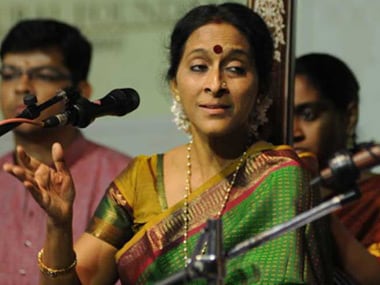Even before the euphoria over the Oscar nomination of celebrated Carnatic vocalist and playback singer Bombay Jayashree for her song in Life of Pi settled, comes the spoiler: an allegation from an erstwhile royal family in Kerala that the singer has lifted portions of her song from a 200-year old lullaby in Malayalam. The charge, according to a
Times of India
report is that two lines of Jayashree’s song are lifted from the legendary lullaby of Irayimman Thampi. “She did not ask our permission so we will file a case against her demanding compensation. She should clear her stand,’’ TOI quoted Rugmini Bhai, a descendant of Thampi and the secretary of a trust named after him. The report also quoted Jayashree dismissing the charge and a Malayalam writer suggesting the singer’s lines showing some “distant echo” of Thampi’s lullaby. [caption id=“attachment_586510” align=“alignleft” width=“380”]
 Bombay Jayashree performing in a concert. Firstpost[/caption] In Kerala, no average child would have gone to sleep, in the last 100 or more years, without listening to Irayimman Thampi’s lullaby, “Omanathinkal Kidavo” (Is this sweet baby, the bright crescent’s moon, or the charming flower of the lotus?). Written for the erstwhile King of Travancore and music exponent Swathi Thirunal, when he was born, the lullaby is structured as a series of questions in which the mother asks the child if he is not the most precious thing in the world. It compares the child with a range of living and unliving things, emotions and senses. Jayashree’s composition, in comparison is much shorter, subtler and totally different in style. The only similarity, even going by the allegation of Rugmini Devi, are in two lines where she tells the child that he is the dancing
peacock
and also the singing koel. Thus goes the fourth line of Thampi’s lullaby: A dancing peacock, or a sweet singing bird ? Is this a lift or the striking similarity of the pure emotions of a mother for her child? Don’t mothers compare their children with anything and everything in this world? Are peacock and the singing bird non-reusable images? There are dime a dozen lullabies in the south, including many film songs, that start with the eyes. Do they preclude the use of eyes, or any imagination related to the eye, by others? The imagery of lullabies and their style are similar because the emotions are similar. A mother’s emotions or her unrestrained expressions cannot be protected by copyright. And the Oscar nomination didn’t come for the alleged references. Even in general poetry, the images and motives are so similar and repetitive. Haven’t we seen the sunflower, rains, the sea, deserts, blood, summer, winter, pain etc in poetry again and again?
Bombay Jayashree performing in a concert. Firstpost[/caption] In Kerala, no average child would have gone to sleep, in the last 100 or more years, without listening to Irayimman Thampi’s lullaby, “Omanathinkal Kidavo” (Is this sweet baby, the bright crescent’s moon, or the charming flower of the lotus?). Written for the erstwhile King of Travancore and music exponent Swathi Thirunal, when he was born, the lullaby is structured as a series of questions in which the mother asks the child if he is not the most precious thing in the world. It compares the child with a range of living and unliving things, emotions and senses. Jayashree’s composition, in comparison is much shorter, subtler and totally different in style. The only similarity, even going by the allegation of Rugmini Devi, are in two lines where she tells the child that he is the dancing
peacock
and also the singing koel. Thus goes the fourth line of Thampi’s lullaby: A dancing peacock, or a sweet singing bird ? Is this a lift or the striking similarity of the pure emotions of a mother for her child? Don’t mothers compare their children with anything and everything in this world? Are peacock and the singing bird non-reusable images? There are dime a dozen lullabies in the south, including many film songs, that start with the eyes. Do they preclude the use of eyes, or any imagination related to the eye, by others? The imagery of lullabies and their style are similar because the emotions are similar. A mother’s emotions or her unrestrained expressions cannot be protected by copyright. And the Oscar nomination didn’t come for the alleged references. Even in general poetry, the images and motives are so similar and repetitive. Haven’t we seen the sunflower, rains, the sea, deserts, blood, summer, winter, pain etc in poetry again and again?
Did Bombay Jayashree copy the legendary Malayalam lullaby?
G Pramod Kumar
• January 13, 2013, 16:42:06 IST
Jayashree’s composition, in comparison is much shorter, subtler and totally different in style. The only similarity, even going by the allegation of Rugmini Devi, are in two lines where she tells the child that he is the dancing peacock and also the singing koel.
Advertisement
)
End of Article